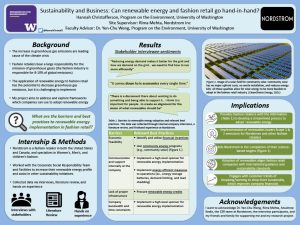Can Renewable Energy and The Fashion Industry Go Hand-in-Hand? Experiences from Nordstrom
Fashion retail is a large source of greenhouse gas (GHG) emissions and accounts for 8 – 10% of GHG emissions globally. Today, GHGs are the leading cause of global climate change. The increase in GHG emissions is and has been detrimental to population health, the environment, and our overall livelihood on Earth. Today, fashion retailers are responsible for decreasing their GHG emissions through actions such as renewable energy adoption. While decreasing GHG emissions is a necessary step, it can be quite difficult to do so. Thus, the purpose of this study was to understand how to sustainably implement renewable energy (RE) in fashion retail by identifying the barriers and best practices to renewable energy adoption. To achieve this goal, I conducted a literature review, performed interviews with internal stakeholders at Nordstrom to understand their perceptions surrounding renewable energy, and incorporated my firsthand experience to develop a memorandum that detailed renewable energy implementation in fashion retail through the lens of Nordstrom. Research showed that four main barriers are: economic feasibility, communication and buy-in, sufficient RE infrastructure, and company bandwidth. In addition, five main best practices are: utilize financial incentives, prioritize joining community energy programs, purchase renewable energy certificates, increase energy efficiency in operations, and implement a high-level sponsor for RE within the company. Looking toward the future, this research provides a basic framework that companies could build upon to increase their renewable energy profile. Doing so would enable fashion retail companies to decrease their GHG emissions through greater use of renewables.
